WEDNESDAY
MARCH 16 - 2016
Spotted
Redshanks
John Arnott
went for a walk down the east side of the Chidham
peninsular to Cobnor Point yesterday early evening
15th March and saw a small flock of six Spotted
Redshanks feeding in the (probably) brackish lagoon
next to the new Harbour Conservancy path at SU 79608
03125. The most he has ever seen in one place! He saw
five to start with half way down the lagoon, then they
flew the short distance to the north end of the
lagoon. They were distinctive in lacking the white
rear wing pattern of Common Redshank. There they were
joined by a sixth bird, forming a tight flock, all
feeding busily up to their bellies in the water. They
had all started to develop their dark breeding
plumage. No rings or other marks were visible. John
says there was also a Great Northern Diver out by the
Chalkdock Beacon.
John did not get a photo, but here is one I borrowed
from the internet of a small flock of Spotted
Redshanks in flight - rather like those described by
John. This shot was in fact taken in Hong Kong!

Collared
Doves
Patrick Murphy
had a pair of Collared Doves picking out niger seeds
from the bird bath which is sited below a niger seed
feeder in his North Emsworth garden. Collared Doves
are fairly common garden birds, ranking 9th in the BTO
Garden BirdWatch list for this time of the year.
However, this has not always been the case as they
only came to the UK in the 1950s, after a rapid spread
across Europe from the Middle East.
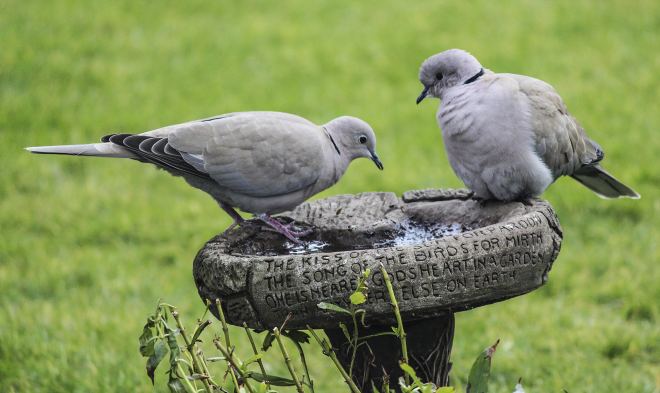
TUESDAY
MARCH 15 - 2016
Coltsfoot
I had a walk
around the local area this morning looking for any
signs of spring. I started with the wayside to the
north of Emsworth Railway Station where I knew
Coltsfoot has flowered in previous years. I was not
terribly optimistic of finding any following the
extensive clearance of much of the area during the
construction of the new cycle racks. However, walking
up the access ramp to the north of the station I
spotted just one bright yellow Coltsfoot flower close
to the yellow railings. This was my first of the year.
There was no others that I could see from the ramp.
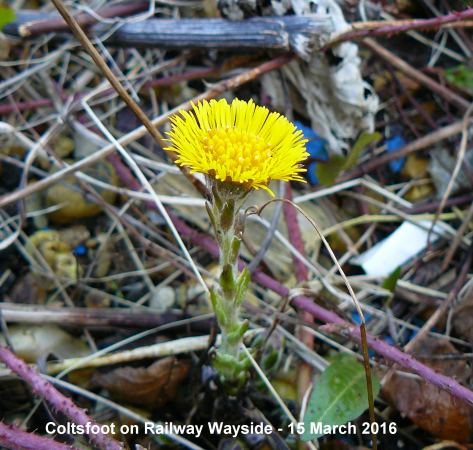
I noted the embankment
vegetation had been cut by the Hollybank Woods group
which was good to see and should encourage new wild
flower growth.
Interbridges
Site
Next I decided
to have a nose around the Interbridges Site to the
east of the Horndean Road which is scheduled for light
industrial development. On the way along the path from
the end of Seagull Lane just north of the railway
arch, I noticed a nice patch of Sweet Violets,
which I do not recall having seen before. It had just
a few dark blue flowers hiding away in characteristic
shrinking fashion so I pulled out one for a photo. I
also had my first Peacock butterfly of the year
further along this path.
The Interbridges Site
itself has been largely cleared of trees and other
plants to make way for the development, which means
lots of disturbed and fresh soil. This might be good
for wild flowers. There is a casual access onto the
site just past the electricity sub station. Here is a
view looking east towards the railway station which
can be seen in the distance in this photo.
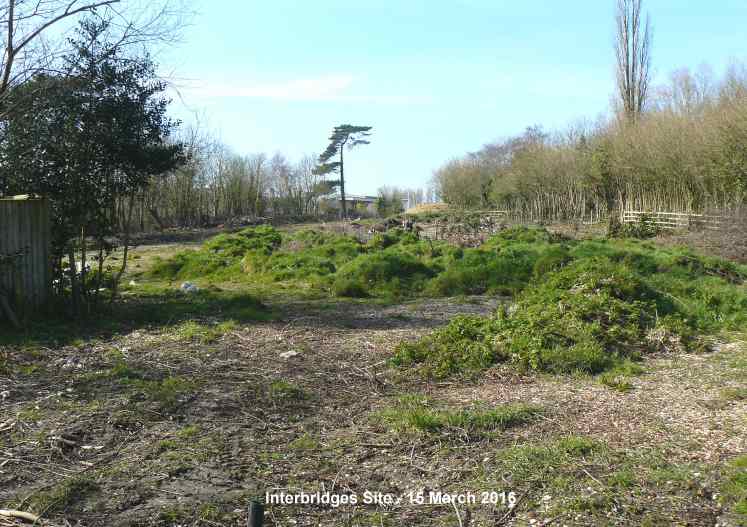
I did not find much of
interest today, though it will be worth looking again
later. When I did some initial surveys for the
planning application way back in 2004, I got a list of
some 80 plant species, though nothing special enough
to stop the development. Today I recorded Common Field
Speedwell, Red Dead-nettle, Lesser Celandine,
Dandelion, Sticky Mouse-ear, Daisy, Groundsel. Here
are Red Dead-nettle - a surprisingly neglected
but attractive plant - and Sticky Mouse-ear.
I also found my first
7-spot Ladybird of the year resting in the
sunshine.
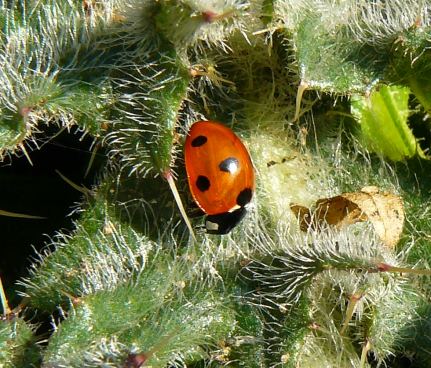
North
Thorney
I decided to
have a walk along the old NRA track to look and listen
for any early summer migrants (of the feathered
variety!). Parking on the corner of Thornham Lane, I
first checked the Alexanders which are a good
feature of this roadside. They were still in flower,
though starting to go over. Walking up the track to
the seawall, there was no sound of either Chiffchaff
or Blackcap which I was hoping for. I heard a burst
from a Cetti's Warbler, though that is not a
migrant.
I walked down to Little Deeps, but there was still no
sign or sound of any migrants. Are they late coming
through this year?
I checked the regular Coltsfoot site in front
of the Little Deeps and found 18 flowers, not
brilliant, but good to see.
I returned to the car at Thornham Lane via the
footpath that goes through the old Marina Farm
stables. The whole site is still closed up 'following
a bereavement' according to a sign on the gate (not
locked). It has been like this for over a year and the
place looks derelict with no sign of life or horses.
Let's hope the Swallows still find a place to nest in
the stables.
Nore
Barn
At about 2.30
I went over to Nore Barn to check on the Spotted
Redshank which is still here, feeding happily
among the seaweed on the shore at the end of
Warblington Road. The colour-ringed Greenshank was
waiting in the stream.
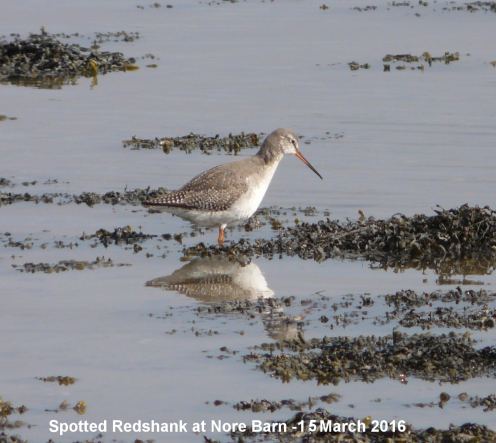
Mystery
plane
Barrie Jay
cleared up the mystery plane with 'OIL SPILL RESPONSE'
printed on the side that Malcolm Phillips photographed
flying low over Brook Meadow on Mar 12.
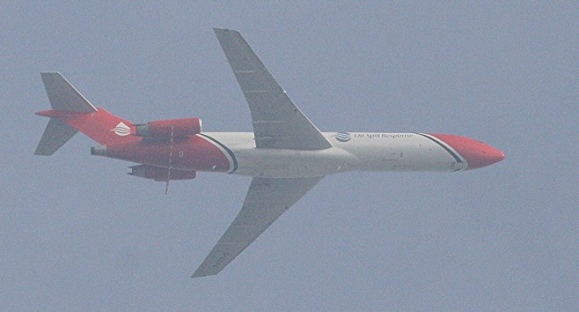
Barrie says . . .
"the
plane is a Boeing 727 - previously an airliner with
several airlines before being retired from passenger
carrying duties. This example, plus two more are to be
converted into tankers carrying oil dispersant for use
against major oil spillage disasters at sea. To date,
thankfully, this aircraft, the first of the three, has
not been called for! They are based at Lasham
airfield, near Alton, so not so far away. This
aircraft G-OSRA regularly conducts tests along the
Solent. The 727 is quite fast and with a good payload
can get to any disasters much quicker than the old
piston planes they
replaced."
Barrie also provided a
picture of a rather tatty, just out of hibernation,
Small Tortoiseshell in his garden yesterday.
This is the first Small Tortoiseshell of the year I
have heard about locally. Good to see and I hope we
get to see lots of them this summer.
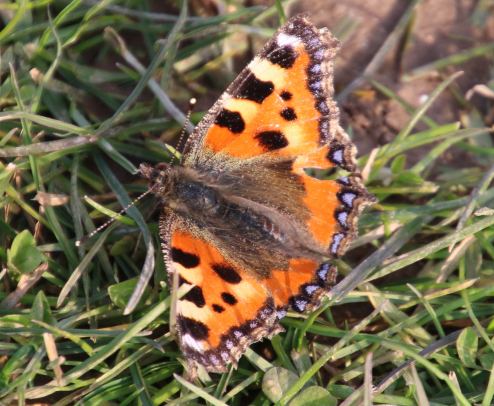
Sexing
Great Black-backed Gulls
Regarding the
photos of the Great Black-backed Gulls tussling with a
dead Eel in yesterday's blog, Tom Bickerton points out
that one can see the size difference between the sexes
- this is quite pronounced in the third photo showing
both gulls with the Eel. The male is at the back, but
its head is bigger and squarer, whereas the female's
head is more rounded and petite (if you could call a
GBBG petite!). Tom says it looks like the female
started with the Eel, but the male ate it.
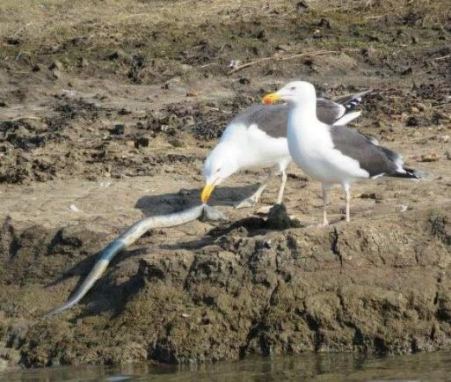
Herring
Gulls in garden
Patrick Murphy
had put out the remains of a chicken carcass assuming
local Magpies and Crows would clear it up, but he was
rather surprised when 3 Herring Gulls landed on the
lawn in his back garden. Patrick says the Herring
Gulls made short work of the chicken remains, but the
poor Black-headed Gull hardly got a look in.
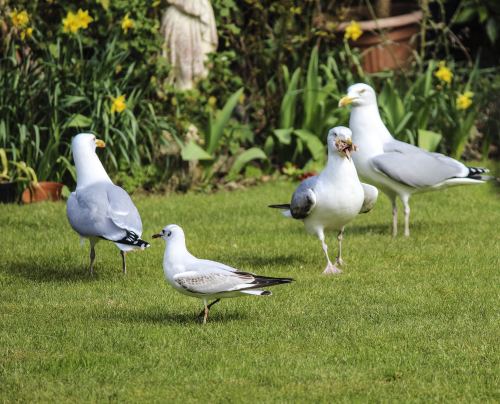
This observation by
Patrick does not surprise me at all. Gulls are
constantly flying over the houses on the look out for
any substantial food that gets put out. They are not
at all interested in bird food!
MONDAY
MARCH 14 - 2016
Black-backed
Gulls with Eel
Steve Dennett
is a regular reader of this blog - Hi Steve. He sent
me three fascinating photos of a pair of Great
Black-backed Gulls (maybe the Slipper Millpond
breeding pair) struggling with a large Eel on Thorney
Island Great Deep. The Eel was about two feet long and
probably weighed 2lb and well and truly dead before
the gulls started playing with it. One of the gulls
almost got the Eel down, but on this occasion not
quite. However, I would suspect the gulls would have
no problem in breaking up the Eel into smaller pieces
for easier consumption.
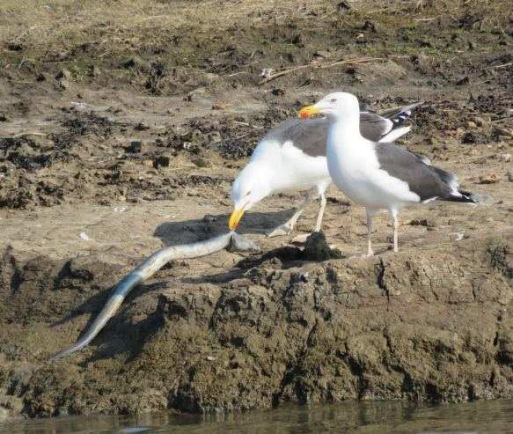
SATURDAY
MARCH 12 - 2016
Spotted
Redshank is still here!
I went over to
Nore Barn again late morning to check on the Spotted
Redshank. It was a beautiful morning with no wind and
a dead calm sea. There was nothing at all in the
stream when I arrived, but I decided to hang around
for a while just in case the bird turned up. I had a
chat with the members of the Nore Barn conservation
group who were just finishing their work session in
the woods. Then at about 12 noon when I was about to
give up I saw our feathered friend flying into the
stream from the harbour with a cheery 'chewitt' call.
So, contrary to my speculation yesterday, the famous
Emsworth Spotted Redshank is still here. I took some
photos just in case we don't see it again, though I
have thousands already in my computer files.
For
the full history of the Emsworth Spotted Redshank go
to . . .
Spotted
Redshanks
Brook
Meadow
Malcolm
Phillips sent his last contribution to the blog for a
while as he is off to Cuba on Monday. As a parting
gift he managed to get the first Peacock
butterfly of the year on the meadow. He also got a
spider which I have not been able to identify. I think
it is one of the Wolf Spiders
(Lycosidae), though I don't think it
is the regular one we usually find on the meadow -
Pisaura mirabilis.
Malcolm also got a
couple of regular year round flies - Drone Fly and
Bluebottle.
Finally, Malcolm
photographed this plane flying quite low over the
meadow with the message on its side OIL SPILL
RESPONSE. He wondered if there was a spillage
somewhere in the channel. Does anyone know anything
about this?
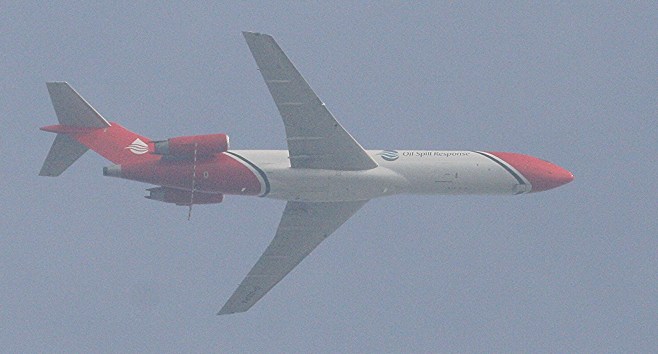
Swan's
eggs!!
During his
walk at Chichester Marina yesterday with the Havant
U3A Photography group Christopher Evans saw a Swan's
nest with 5 eggs in it. I queried this since it would
be much too early for Mute Swan eggs. Christopher
thinks it must have been the nest of a Black Swan, one
of which was seen in the vicinity. Black Swans being
Australian birds will, of course, nest 'out of season'
and this could be the answer. Christopher provided a
link to a story in a Torquay newspaper which appears
to confirm this. See . . . http://www.torquayheraldexpress.co.uk/Dawlish-s-famous-black-swans-cygnets/story-28905419-detail/story.html
Tony's
gallery
Tony Wootton
got a good number of fine images from his visit to
Southmoor yesterday. Here is a selection:
Male Goldeneye,
Mediterranean Gull in flight, Ringed Plover and
Red-breasted Mergansers taking off
FRIDAY
MARCH 11 - 2016
Spotted
Redshank gone?
I cycled over
to Nore Barn at about 11am this morning mainly to
check on the Spotted Redshank. The tide was rising to
high water in about two hours and the stream was
gradually filling. The colour-ringed Greenshank
G+GL was present in the stream, but there was no
sign of the Spotted Redshank. I waited around for
about an hour as the tide came in, but the Spotted
Redshank still did not make an appearance. The
Greenshank was present all this time. This could be
significant as it could well mark the departure of the
Spotted Redshank for its breeding grounds, though I
shall need to check again. My last sighting of the
Spotted Redshank this year was on Mar 8 which could be
a record latest sighting for this bird, the previous
latest was on 09-Mar-2012.
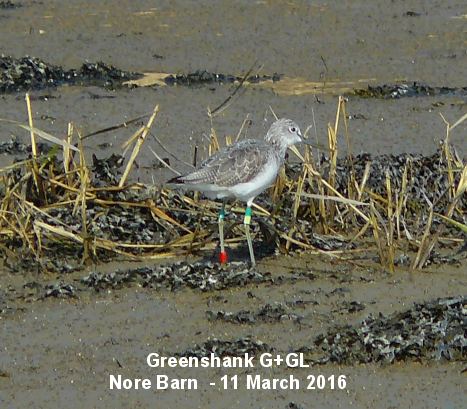
Poorly
Gull
We have had a
what looks like a poorly Black-headed Gull wandering
around in the garden for the past day or so, picking
here and there at morsels of food on the ground. I
have tried shooing it off, but it did not go. However,
when I got back from Nore Barn this morning it had
gone, so I suppose it either flew off or, more likely,
got picked off by one of the local cats.
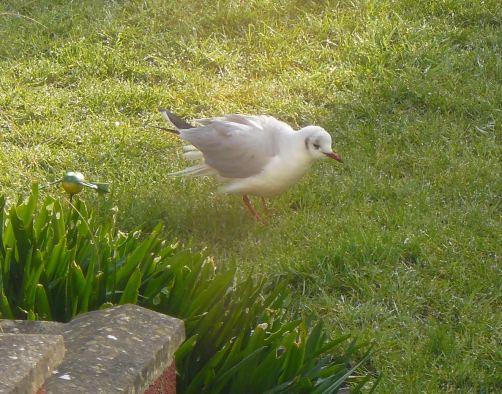
Bank
Vole
Malcolm
Phillips was on Brook Meadow as usual today and got a
photo of a little creature that he has been seeing for
a week but, until today, he had not got a photo of. He
said it was on a pile of logs at the south bridge. I
think it could be either Bank Vole or Field Vole, but
from its chestnut-brown coat my guess is Bank Vole.
Well done, Malcolm. This was our first sighting of
this elusive animal for over a year. Malcolm also got
our last sighting (and photo) of Bank Vole in 2015 on
13-Jan-15.
Southsea
birds
Barrie Jay had
a good walk along Southsea promenade in the sunshine
today - like I did yesterday. He saw 2 Purple
Sandpipers on the rocks in front of the Castle. He
asks if others have now moved off towards their
breeding grounds. That is likely, though these birds
do tend to hang on later than most. Barrie also has a
query about this duck on the side of Canoe Lake. Yes,
that's a funny one, Barrie. It is a some sort of
hybrid Mallard probably mixed with a domestic
duck.
Chichester
Marina
Christopher
Evans was at Chichester Marina this afternoon with the
Havant U3A Photography group enjoying glorious weather
and the mix of wildlife and numerous opportunities for
photos featuring reflections. At the end of the
afternoon, Doug Yelland found a Great Northern
Diver by the pontoon that leads away from the lock
which caused great excitement. Earlier the group had
seen a Black Swan - probably on migration from
West Ashling Pond where there has been a small
breeding colony for many years.
Postcard
from Turkey
Peter
Milinets-Raby is enjoying a family holiday in southern
Turkey. He says there are not many birds to be seen -
in comparison with Langstone Mill Pond - but he did
get this little chap called a Yellow vented Bulbul
with his phone.
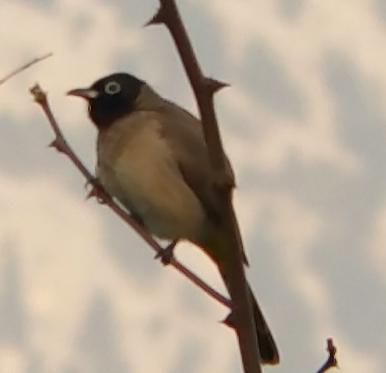
THURSDAY
MARCH 10 - 2016
Southsea
Jean and I
went down to Southsea this morning and had a walk
along the prom towards South Parade Pier. The regular
immature Shag was on Canoe Lake along with 34 Mute
Swans. We stopped at the ever-popular 10th Hole Cafe
for lunch from where we saw a flock of roughly 400
Brent Geese feeding on the adjacent golf course.
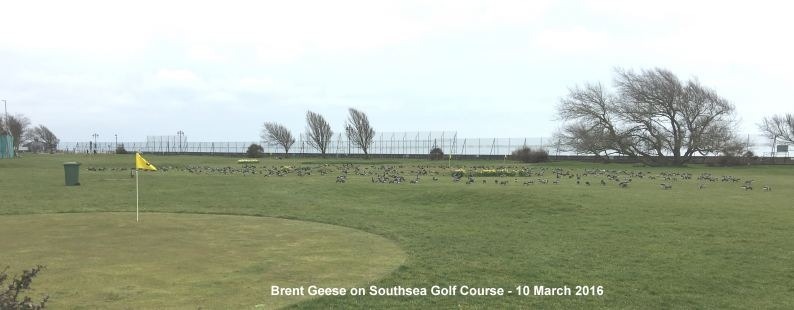
They later moved onto
the cricket field to the west. As we were coming home
along the Eastern Road, we saw another large flock of
Brent Geese on the Salterns Golf Course. These are
pre-migration gatherings, where the birds fatten up
before their journeys.
Goldcrests
Goldcrests
have been prominent this winter, particularly on Brook
Meadow where Malcolm Phillips has had lots of
sightings and got numerous excellent photos of these
tiny delightful birds. But today, even he was
surprised. As he was watching a pair of Goldcrests
near the S-bend in the river, trying to get a photo of
them, a third Goldcrest arrived which had what Malcolm
described as "an amazing crest, much brighter and
bigger than I have seen before". Male Goldcrest has a
bright orange crown which becomes flared open when the
bird is excited. My guess is that Malcolm saw an
intruding male attempting to impress a female with the
size and colour of its crest.
Great
Crested Grebes
Tony Wootton went over to Chichester Gravel Pits this
morning searching for courting Great Crested Grebes -
certainly the best place locally to see these splendid
birds in action. Tony did not see any courtship
displays - maybe it is a bit early in the year for
them? However, he did get this fine male displaying
its ornately crested black and orange head. Tony did
get one clear sign of spring - a Chiffchaff song, the
first I have heard about this year.
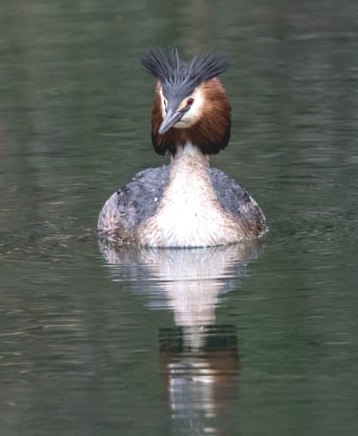
TUESDAY
MARCH 8 - 2016
Nore
Barn
I walked to
Nore Barn early this afternoon, mainly to check on the
Spotted Redshank. The water was still well in,
but the ever-faithful bird was there as usual feeding
on the seaweed on the shore. A Little Egret was in the
stream nearby. But little else.
On the way along
Warblington Road I stopped to take a photo of the
Sweet Violets on the grass verge near the
junction with Valetta Park - still looking very good!
I also stopped to admire the profusion of
Three-cornered Garlic plants near junction with
Kings Road.
Meanwhile, the newly
crowned King and Queen Mute Swans of the town millpond
were busy guarding the small entrance wall to the pond
near the Slipper Sailing Club to repel any invaders.
They have shown no interest whatsoever in nest
building as yet.
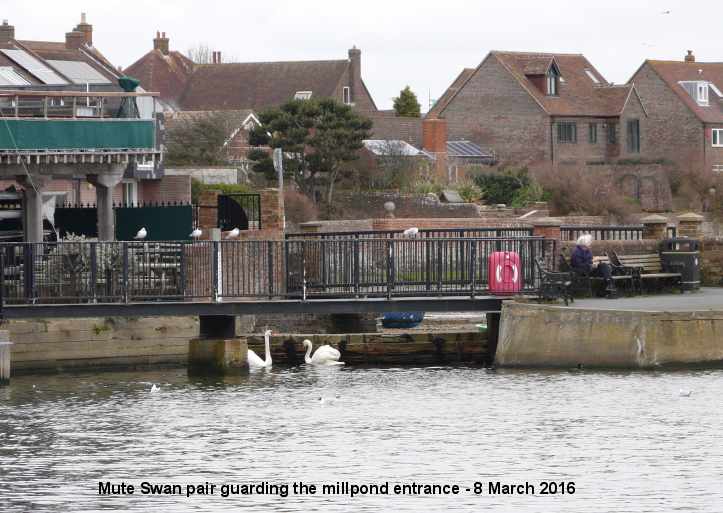
Malcolm's
gallery
Malcolm
Phillips went to Langstone today and then walked back
to Havant along the old railway line. He sent me a
large collection of photos from which I have selected
the following which caught my attention. He also got
the Langstone Water Rail, but we have had a surplus of
those this winter!
Collared Dove - a
sadly neglected bird in this blog, but this one is a
beauty
Starling exploring a tree hole as a nest site. Mmm,
this is a nice one.
Pied Wagtail having a
drink
House Sparrows mimicking Swallows
Mallards vigorously
mating. But does the poor female really enjoy it?
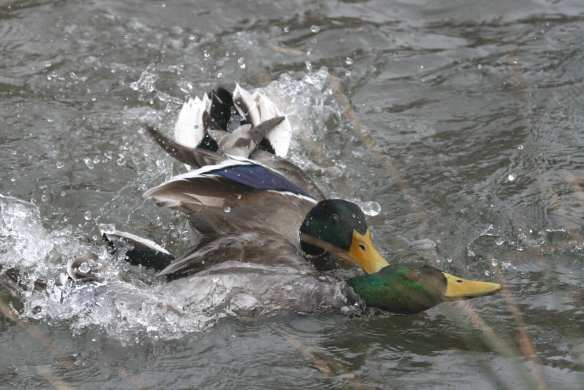
MONDAY
MARCH 7 - 2016
Malcolm's
gallery
Malcolm
Phillips was on Brook Meadow today and got a couple of
action shots with Long-tailed Tit and Magpie taking
off.
Mike's
gallery
Mike Wells
spent a very pleasant, although rather cool, morning
at the Hayling Billy Line/ Oyster Beds and got a
number of excellent images of the local birds: Curlew,
Rock Pipit, Great Crested Grebe, and Greenshank.
Early
Bluebells
While dog
walking yesterday in Ashling Wood, Dave Perks spotted
a very small number (less than 10) Bluebells just
coming into flower. This is incredibly early, though
this is an incredible winter, so I suppose we have to
expect the unexpected! I must get over there to have a
look for myself, though, as Dave rightly points out,
we may have to wait awhile to see them in their full
glory. My earliest ever sighting of flowering
Bluebells in Ashling Wood was on 23 Mar 2014 and last
year they were not open until well into April. Here is
a shot I got of them in late April last year.
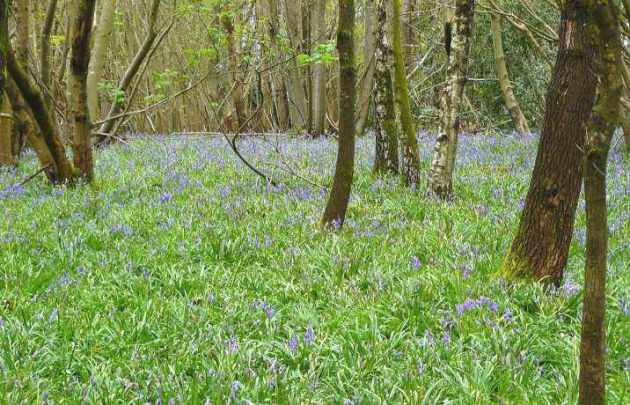
SUNDAY
MARCH 6 - 2016
Clean
for the Queen on Brook Meadow
I went over to
Brook Meadow this morning for the special work session
focussing on the 'Clean for the Queen' litter
clearance campaign. There was a good turn out of about
12 volunteers, including Jayne Lake from HBC and
newcomers Jo Jenkins and her daughter Rhiannon.
Volunteers were allocated to various litter picking
jobs in and around the meadow. Meanwhile, Maurice and
Nigel planted the two Silver Birch trees on the
causeway which were donated by Alison West of Oak
Meadow Close, Emsworth. Jo brought a delicious home
made jam sponge cake which we all sampled at coffee
break. At the end of the session all the bags of
litter and other rubbish were collected together for
collection by Council workers. Unusual items included
an old wheelbarrow and a car wheel.
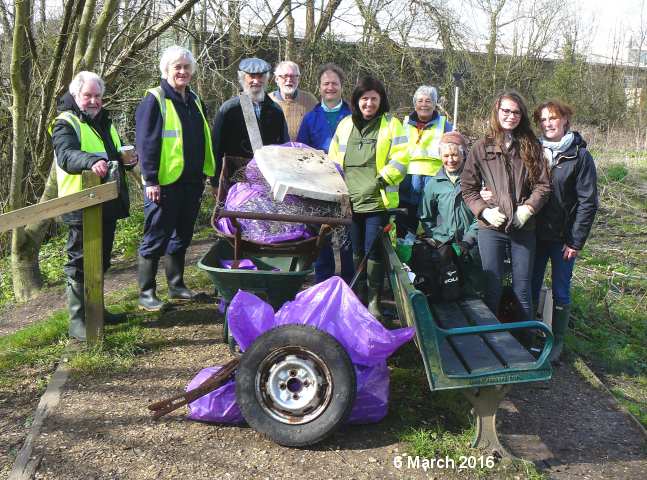
More photos to come
late on the Brook Meadow web site at . . .
http://www.brook-meadow.hampshire.org.uk/bm-diary-current.html
Scarlet
Elf Cup fungus
While they
were clearing litter from the Lumley copse Jo and her
daughter Rhiannon came across some small bright red
fungi growing on a rotting twig. I personally had not
seen this fungus before, but putting 'red fungus' into
Google quickly gave me the identification as Scarlet
Elf Cup (Sacroscypha coccinea). This
attractive fungus was a first for Brook Meadow.
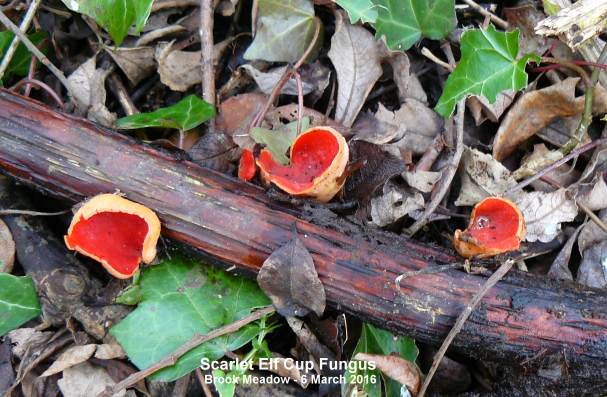
The habitat in which
the fungi were found in was exactly right as it grows
on decaying sticks and branches in damp spots in
woodland areas, usually buried under leaf litter or
even in the soil. This was the case with the present
samples as I had to pull the twig they were on out of
the soil. Scarlet Elf Cup is not a rare fungus and is
widely distributed across the Northern Hemisphere and
usually appears in winter and early spring. It is also
an edible fungus and Dan, one of the volunteers, who
does some foraging, says they are quite tasty!
There is a delightful video on YouTube of a lady
discovering some Scarlet Elf Cups at . . .
https://www.youtube.com/watch?v=FTe3EouS-Hw
Other
observations
A
Buzzard was soaring overhead during much of the
work session.
Pam Phillips reported a Rabbit on the meadow a
couple of days ago. Rabbit is quite a rare animal on
the meadow with only one or two sightings each year.
In fact, the last sighting reported to me was by
Malcolm Phillips on 27 June 2014.
Blackbirds
I received
excellent photos of Blackbirds today, a male from
Malcolm Phillips on Brook Meadow and a female from
Barrie Jay in his garden. Barry adds that the female
Blackbirds are more mottled brown than usual this
year. I can't say I have noticed this, but will look
out for them. Note many of the Blackbirds we see at
this time of the year will be migrants from the
Continent that spent the winter here, though they will
soon be returning. Incidentally, I have noticed a
sharp increase in Blackbird song over the past week,
particularly near dusk. A wonderfully rich and relaxed
delivery. Only the male sings.
SATURDAY
MARCH 5 - 2016
Langstone
swan nest
Ralph Hollins
was very surprised to see the photo by Christopher
Evans (in yesterday's blog) of the Mute Swan
apparently settling on a nest on the narrow bank of
the Mill Stream at Langstone close to where it flows
under the footbridge. Ralph has never seen this site
used by Swans in the forty years he has been walking
past the Mill Pond.
When Ralph checked the site this morning he saw
neither a Swan nor a nest-shaped depression where
Christopher saw the Swan yesterday. However, he did
see the Swan apparently on a nest at the north end of
the island near the footpath. At first the Swan
appeared to be asleep with its neck and head resting
on its back but it soon raised its head and started
collecting material to add to the nest from the area
it could reach without rising from its 'sitting'
position on the nest.
Ralph added, "I feel certain that this is the chosen
nest for this year and that the absence from view of
the female Swan on my visits over the past week or so
have been because the Swan has been working her way
around the periphery of the pond checking out all the
possible nest sites before deciding on the one I saw
today".
FRIDAY
MARCH 4 - 2016
Millpond
News
This morning a
Cormorant was sitting really snugly on the south raft
of Slipper Millpond, enjoying the warm sunshine. There
was no sign of the Great Black-backed Gulls, but three
adult Herring Gulls were on the water, but unlikely to
stay.
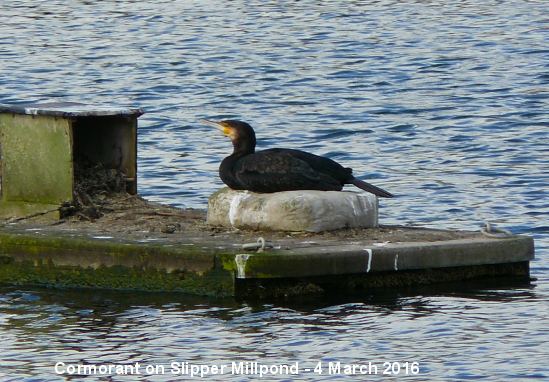
A pair of Mute Swans
was on Peter Pond and looking very settled. I am quite
optimistic they will get around to nesting. Here is a
nice photo of the pair that Malcolm Phillips got when
he was here this morning.
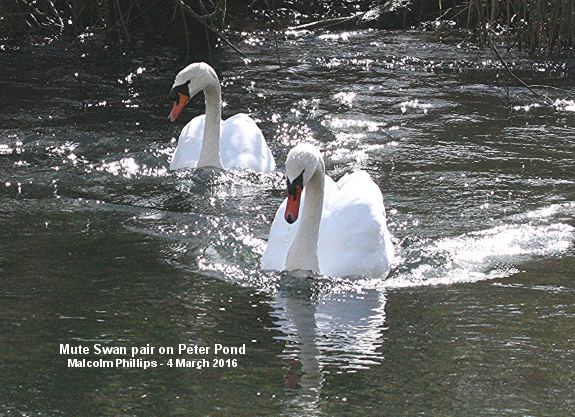
It was good to see
Hazel catkins shining in the sunshine to the
north of Peter Pond.
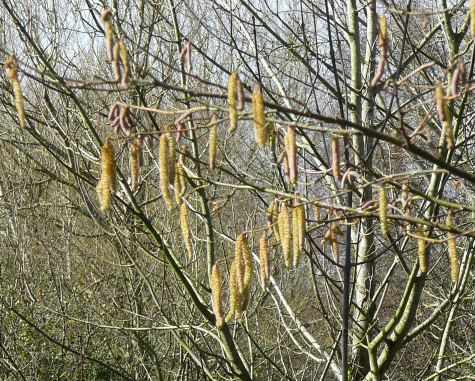
I met my friend John
who reported seeing a Water Vole in the millstream at
Westbourne. Let's hope they move downstream onto Brook
Meadow.
Bird
song
During this
morning's walk, I was interested to hear several
different Great Tit calls in addition to the
classic 'teacher-teacher' song. I gather that over 60
different Great Tit calls have been recorded, which
clearly accounts for the birder's adage 'if in doubt,
go for Great Tit'. Malcolm Phillips got a photo of
what could have been one of the songsters when he was
on the meadow this morning.
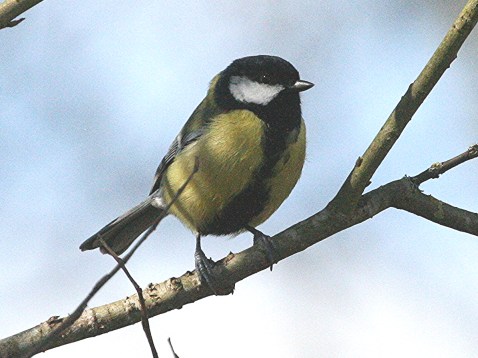
This afternoon I heard
two Blackbirds singing, one from gardens behind
Bridge Road car park and the other from a garden close
to the Community Centre.
Bumblebee
Malcolm
Phillips got a photo of a Bumblebee feeding on a
Cherry Plum blossom.
From its ginger thorax my guess is Bombus
hypnorum.
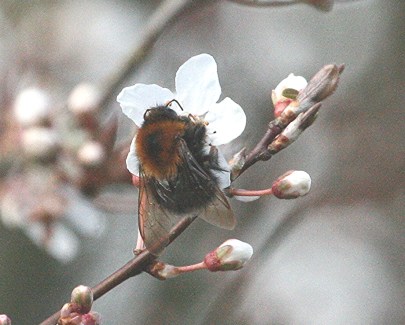
Langstone
swans
Christopher
Evans went down to Langstone late this afternoon and
noticed that Mute Swans had selected their nest site.
Going west past the millpond towards the Royal Oak, it
is in the reeds on the right just before you cross the
stream. More visible than last year. Is this the first
local Mute Swan of the year?
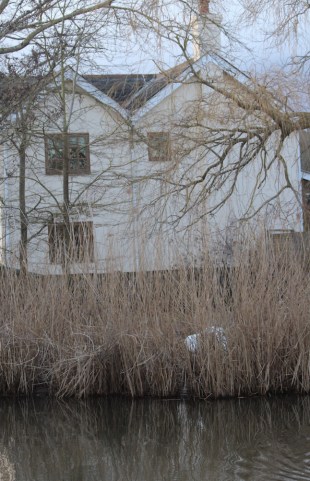
At the eastern end of
the pond, Christopher a Kingfisher flash across the
pond into the reeds at the rear. Earlier, he had
another sighting of the Southmoor Short Eared
Owl.
THURSDAY
MARCH 3 - 2016
Blackcap
song
While
replenishing the bird table this morning I heard the
unmistakable rich fluty song of a Blackcap from a
neighbour's garden. What a great sound for a fine and
spring-like morning. However, this is almost certainly
one of our wintering birds from the continent
limbering up in preparation for its journey back to
its breeding grounds in Germany possibly. It was not
unexpected as I usually hear one at this time of the
year; last year I heard Blackcap song on Mar 10 also
from a local garden adjacent to Bridge Road car
park.
Wintering and summering Blackcaps tend to overlap at
this time of the year and are not easily separated.
However, they tend to go for different habitats;
wintering Blackcaps head for gardens where they are
often seen on feeders; summer birds generally avoid
gardens (unless they are large ones) and go for
breeding habitats, such as Brook Meadow or Hollybank
Woods.
Here is a nice
photo of a male Blackcap in full voice
taken by Richard Somerscocks in April 2012.
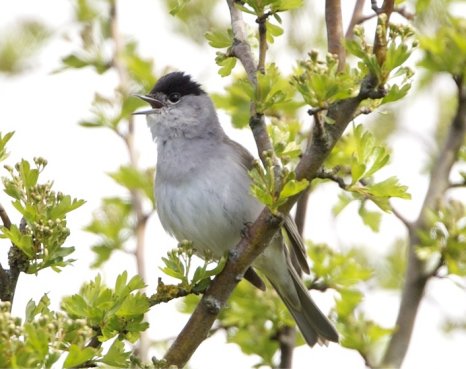
Spotted
Redshank
I popped over
Nore Barn this afternoon at about 3.15pm. The tide was
still well out and the stream was virtually empty.
However, the ever-faithful Spotted Redshank was
present on the edge of the stream, all alone. It could
be here for a little while yet, as my final sighting
last year was 20 March, though this was late. I have a
feeling that it will be gone early this year. Most
other wintering birds seem to have gone already; there
was hardly anything else in the harbour this afternoon
apart from a few Teal, Oystercatchers and gulls.
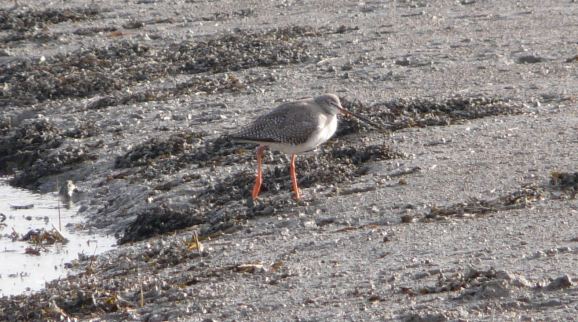
More
harbour birds
Ralph Hollins
sent me two photos - see below - from an ex-IBM
friend, Paul Heyes, who now lives in Horndean, but
visited Emsworth this afternoon. One is of a male
Goldeneye taken in Emsworth Harbour. The other is
a fine image of our regular colour-ringed
Greenshank G+GL which I assume was taken in the
stream at Nore Barn. I also assume the Spotted
Redshank was not present at the time else Paul would
have got that one too. I saw Greenshank G+GL on the
shore to the east of Emsworth yesterday, but it was
not at Nore Barn when I got the Spotted Redshank this
afternoon.
Sexing
Water Rails
Regarding the
query from Maureen Power in yesterday's blog about how
to sex Water Rails, Ralph Hollins says, "The short
answer is that there is no reliable way of
distinguishing males and females." Ralph referred to
Wikipedia which says that males typically weigh
114-164 g (4.0-5.8 oz) and females are slightly
lighter at 92-107 g (3.2-3.8 oz) and that the sexes
are similar; although the female averages slightly
smaller than the male, with a more slender bill,
determining sex through measurements alone is
unreliable.
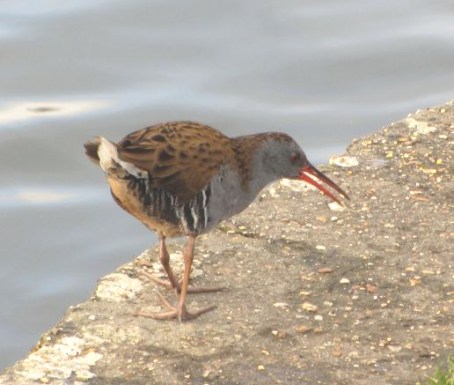
However, Tom
Bickerton, to whom I referred yesterday, is fairly
sure the Water Rail sexes can be distinguished. He
says, " The male has a broader bill at the base, it
can be quite distinct, if you can get a good side
elevation view of the bird. You can't really tell from
this from Maureen Power's image as the bill is open,
but it looks male. Somehow it seems easier in the
field than from an image, just like male and female
Buzzard. "
Short-eared
Owls on Thorney
Christopher
Evans went out with the Havant U3A Birdwatching Group
on Thorney today and was delighted to see at least
three Short-eared Owls. I happened to meet Barry and
Margaret Collins in Havant this afternoon. Barry was a
conservation warden on Thorney Island until recently
and knows more about the island than anyone else! He
confirms that this has been a bumper year for
Short-eared Owls, though not up to 1991 which was the
best in his memory when they had two roosts on the
island. I think that was the year when I had my best
ever sighting of seven Short-eared Owls quartering the
Tournerbury Farm marshes during a WeBS count.
Here is a cracking
shot of one in flight taken by Tony Wootton at
Farlington Marshes on 16 Feb this year.
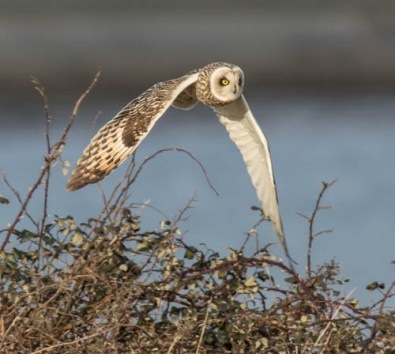
Early
Bluebells?
Tony and
Hilary Wootton walked around a Hampshire Wildlife
Trust reserve called The Moors today, just South of
Bishops Waltham, and saw some Bluebells in flower.
Tony says he doesn't know if they're Spanish but they
are the first they have seen this year.
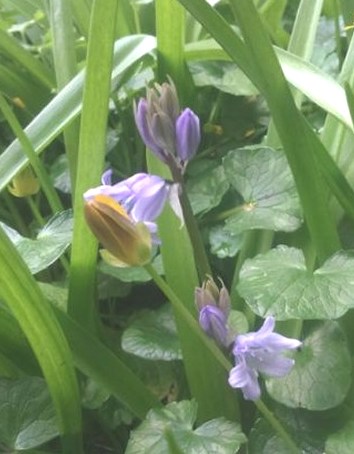
From Tony's photo the
flowers look rather upright and remind me of the
Spanish variety. I would expect native Bluebells to be
more drooping. In any case, it is really far too early
for native Bluebells. I usually check them at Ashling
Wood in West Sussex and my earliest ever sighting was
on 23 Mar 2014. Last year they were not open until
well into April. Bluebells are always later emerging
in Hollybank Woods. Here is a classic native Bluebell
which I took in Hollybank Woods a few years ago for
comparison.
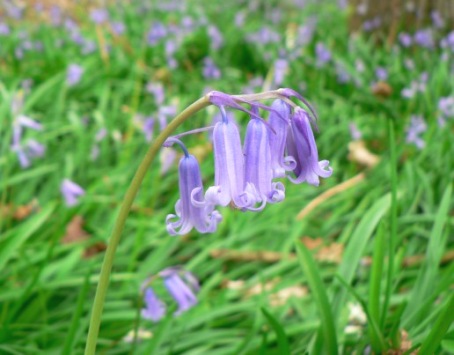
Starling
Leighton
Barrable was very impressed with this Starling which
he took today in Southsea. What a cracker! The bird
still has lots of the white speckling of its winter
plumage, but the iridescent blues and greens of the
breeding plumage are coming through. Leighton was not
sure of its sex, but from the blue-grey colouring at
the base if its bill I would guess at a male.
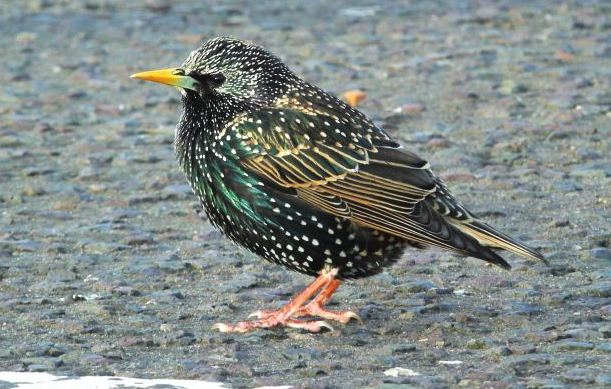
Barrable also sent me
a photo of a gull, wondering if it was a Black-headed
or a Mediterranean Gull. Barrable's photo is on the
left and is clearly a Black-headed Gull - a Med Gull
is on the right for comparison - taken a few years ago
at Eastney. The main differences are in the head
pattern, the bill colour but, critically, the absence
of black wing tips in the Med Gull
WEDNESDAY
MARCH 2 - 2016
Langstone
Water Rail
Maureen Power
got an excellent photo of the Langstone Water Rail
yesterday (March 1st) afternoon, as it was feeding on
some bird seed. Gosh, this bird is so tame, a
photographer's dream bird. It reminds me of a
similarly tame bird that we had at Baffins Pond many
years ago which also used to come onto the path to
take food. Sadly, we have had no sighting of Water
Rail at all on Brook Meadow this winter, despite a lot
of searching.
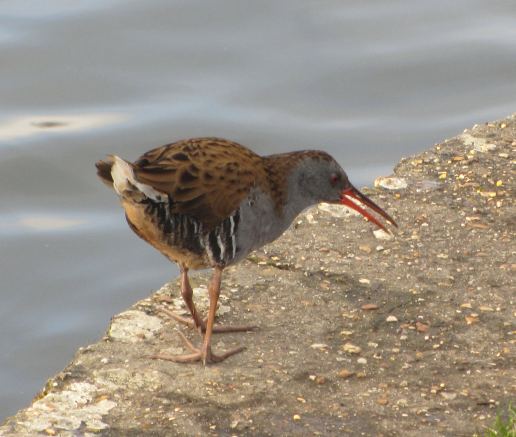
Maureen asked if there
was more than one Water Rail at Langstone. I don't
know the answer, but we have never had a sighting of
two birds, so probably not. Maureen also asks about
telling the sex of the bird. I recall Tom Bickerton
telling me how this could be done, but I can't
remember how. It's pretty difficult I should say.
New
Forest wildlife
For those
interested in the New Forest and its wildlife, Russell
Wynn and Marcus Ward (Wild New Forest co-ordinators)
have set up a new resource called 'Wild New Forest'
with the primary aim of supporting local conservation
and outreach activities. The website can be found at
the link below, and contains an illustrated blog,
monthly sightings, survey details, forthcoming events
and more. Recent blogs include topics as diverse as
nocturnal Woodcock ringing, Raft Spiders and Water
Crickets, Sea Trout, colour-ringed Firecrests, and
Hawfinch roost surveys. Blogs coming up this month are
likely to cover Jackdaw roosts, False Widow Spiders,
mammal camera trapping, and a Hawfinch survey update.
The February sightings report will be uploaded this
weekend.
Web site . . . http://www.wildnewforest.co.uk
They have also set up
a Facebook page for more rapid dissemination of news,
images and video. Posts from the last couple of days
show camera trap images of Badgers and Red Deer, video
and photo evidence of New Forest ponies stripping bark
off beech trees (which has helped trigger management
action by the relevant authorities), Great Crested
Newt activity, and a Hawfinch bait station. Facebook
page . . . https://www.facebook.com/groups/482338708635345/
Local
groups on Twitter
Two of our
local conservation groups now have adopted Twitter
feeds as a means of communicating news. There are
links to both Twitter feeds on the regular web sites.
Twitter and Facebook certainly have attractions, but
for the time being I am happy to carry on with the
old-fashioned web site blog. Here are the Twitter
links.
Hollybank Woods - https://twitter.com/HollybankWoods
Friends of Emsworth Waysides - https://twitter.com/emsworthwayside
On the waysides link I learned that a team from the
Hollybank conservation group had done a good job
cutting the Railway Wayside to the north of the
station on Feb 29.
Pesticide-free
Havant
An
organisation called Pesticide Action Network (PAN) has
mounted a campaign calling on all local councils to
stop using toxic chemicals on roads, parks, waysides
etc. Their target locally is Havant Borough Council -
so please give them your support. The sight of some
young chap going round the roads spraying nasty
chemicals is not pleasant and the resulting ugly brown
marks are scars on the environment. They even do it
around trees and posts!
When we first started the Friends of Emsworth Waysides
a few years ago I did my best to persuade the Council
to stop this unecological practice, but we did not get
anywhere. 'It saves money' was the usual reply. But
what about the environment? Personally, if I catch one
of these chaps spraying the street where I live I tell
him to stop. We should all do this. Don't allow your
local patch to be defaced by these nasty
chemicals.
But not just that go one step further to put a stop to
this out-of-date and unecological practice by
supporting this campaign by PAN. You can find out more
from their web site at . . . . http://www.pan-uk.org/pesticide-free-towns-and-cities/
The local co-ordinator
is Patricia Williamson Tel: 01243 378560 E-mail:
p.ivy@tiscali.co.uk
I also urge you to sign the online petition at . . .
https://petition.parliament.uk/petitions/109257
My signature was number 1,133 so there is a long way
to go to get to the magic 10,000 when the government
are required to respond.
TUESDAY
MARCH 1 - 2016
Little
Egret in garden
We often see a
Little Egret perched on the garden wall at the end of
our garden prior to its leaping down into the
Westbrook Stream for little fish. However, we have
never ever seen one in the garden itself until this
morning when my wife excitedly called me to the
kitchen where she was watching one striding around on
the grass. I quickly got a few shots with my camera
through the window before the bird flew off to perch
in a neighbour's tree. To think I had to go all the
way to Spain some 30 years ago to see one of these
birds and now here they are in my back garden.
Amazing.
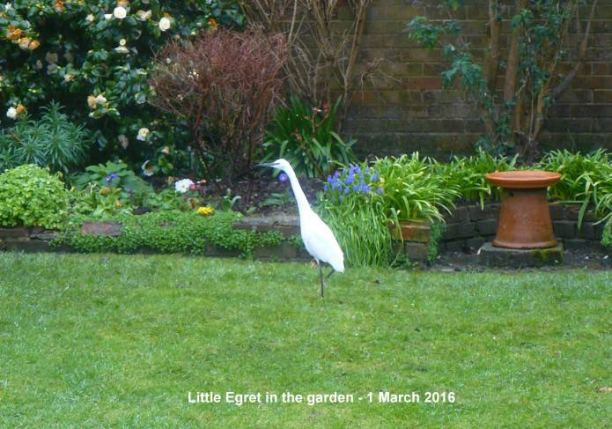
Mystery
Grebe solved
A couple of
days ago I had an e-mail from Ann Davies reporting
what she thought was a Slavonian Grebe fishing in
Emsworth Harbour just below her garden wall
overlooking the harbour. Ann added that the bird was
larger than a Little Grebe with a longer neck which
sounded more like a Great Crested Grebe than a rare
Slavonian Grebe. As luck would have it, I spotted a
diving bird fishing close to the eastern harbour wall
when I was passing this afternoon. I got a distant
snap of the bird to confirm the identification as a
Great Crested Grebe. Maybe this was Ann's mystery
grebe? This was the first Great Crested I have seen in
Emsworth this winter; they usually come onto the town
millpond, but I have not seen one there this year.
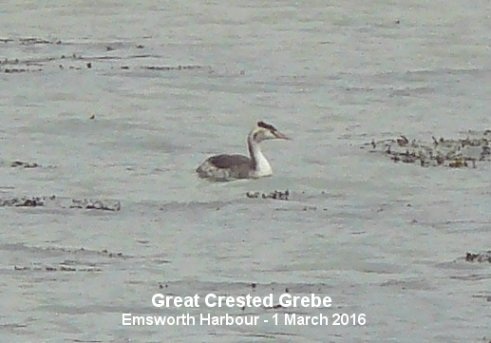
While on the shore, I
also found a Common Redshank and a colour-ringed
Greenshank G+GL feeding among the seaweed. This is, of
course, the Greenshank that regularly feeds in the
Nore Barn stream in company with the Spotted Redshank.
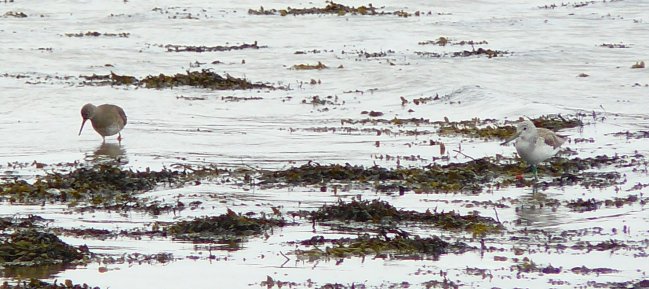
Little
Egrets at Warblington
John Jury
counted 21 Little Egrets in the cattle field to north
of Pook Lane in Warblington this morning. These will
be assembling for the nesting season at Langstone Mill
Pond.
Ringed
Long-tailed Tit
Hot on the
heels of the ringed Marsh Tit, Mike Wells photographed
another ringed species at QE Park yesterday - a
Long-tailed Tit. As he says, 'Someone's been very busy
with the rings!'
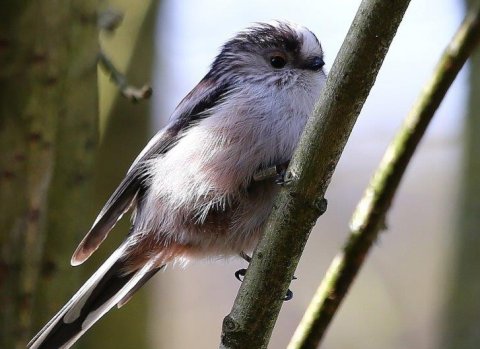
Dolphin
in Chichester Harbour
In his review
of February's wildlife, Ralph Hollins discusses the
Dolphin that was seen several times in Chichester
Harbour this month - including one reported to this
blog by Barry Kingsmith at Langstone on Feb 14. It
seems that this was the first Dolphin to enter
Chichester Harbour for a least ten years and Ralph
thinks it could have been injured after a collision
with a ship. For more details see . . .
http://ralph-hollins.net/Diary.htm
For
earlier observations go to . . February
15-29